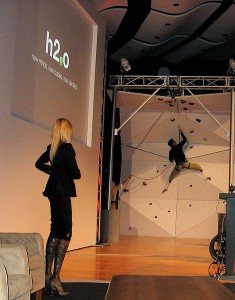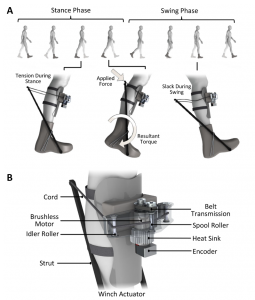A new paper published today has shown that a simple exoskeleton can augment human walking. This is just one of many exciting new developments emerging from a lab at MIT which are bringing humans and machines ever closer together.
Let me tell you a story. In 1982, a young man suffered severe frostbite in a climbing accident. After being rescued, both of his legs had to be amputated below the knee. A passionate rock climber, who had been acknowledged as one of the best in the country, this man decided that the loss of his legs wasn’t going to stop him.

After months of surgeries and rehabilitation, he was back on the rock face, using specialized prostheses that he had designed himself. The use of these prostheses let him climb at a more advanced level than he had before the accident, making him the first person with a major amputation to perform in a sport on par with elite-level, able-bodied people.
If the story ended here, this man would be an inspiration to many, but this was only the beginning. Hugh Herr is now an Associate Professor at MIT, with a degree in physics, a masters in mechanical engineering and a PhD in biophysics. His lab is developing technology that’s improving people’s lives every day, helping those who have leg conditions to walk, run, climb, and even dance.
“Every person should have the right to live life without disability, if they so choose,” said Herr in his TED talk filmed just two months ago (and which I highly recommend watching).
“As a society we can achieve these human rights if we accept the basic proposition that humans are not disabled. A person can never be broken. Our built environment, our technologies, are broken and disabled. We, the people, need not accept our limitations, but can transcend disability through technological innovation.”
Today, we published a new paper in Journal of NeuroEngineering and Rehabilitation by Professor Herr, graduate student Luke Mooney and postdoc Elliott Rouse, demonstrating the use of a leg exoskeleton which reduces the metabolic energy cost of the body while walking.
This exoskeleton is one in a long line of technological developments that Professor Herr has worked on, and which he speaks about in his TED talk. And as the exoskeleton shows, it’s not just those with physical disabilities that can benefit from this work. Professor Herr is developing technology that can make us all a bit ‘super’.

The exoskeleton (which you can hear Herr speak about at 09:34 into his talk) has been designed to reduce the energy needed to walk whilst carrying loads. Indeed, it reduces the metabolic cost of walking, full stop. So much so that test subjects found their own limbs “felt ridiculously heavy and awkward” after walking in the exoskeleton for 40 minutes and then removing it.
According to the researchers, the first leg exoskeleton that posited to augment human walking was patented in the late 19th century. Since then, interest in developing exoskeletons that improve human strength and ability has grown substantially.
However, prior to the publication of this paper, the authors state that they couldn’t find any other example of an autonomous exoskeleton that showed a significant reduction in the energy needed to walk. (Autonomous meaning that the exoskeleton is self-contained, operating with no links to external equipment, such as external power supplies).
In the study, participants wore a 23kg vest and the metabolic cost of their walking in it was measured both with and without the exoskeleton. The researchers found that the exoskeleton reduced the metabolic cost by 8%, making it easier for the wearers to bear the heavy load.
This study which, for me at least, conjures up future visions of Marvel’s Iron Man, is yet another step on the road to a future where humans and machines are ever more closely linked together. A future that Herr envisions in his TED talk:
“In the future we’ll all be wearing exoskeletons for such common activities as running,” he says. “We’re beginning the age in which machines attached to our bodies will make us stronger and faster and more efficient.”
Comments